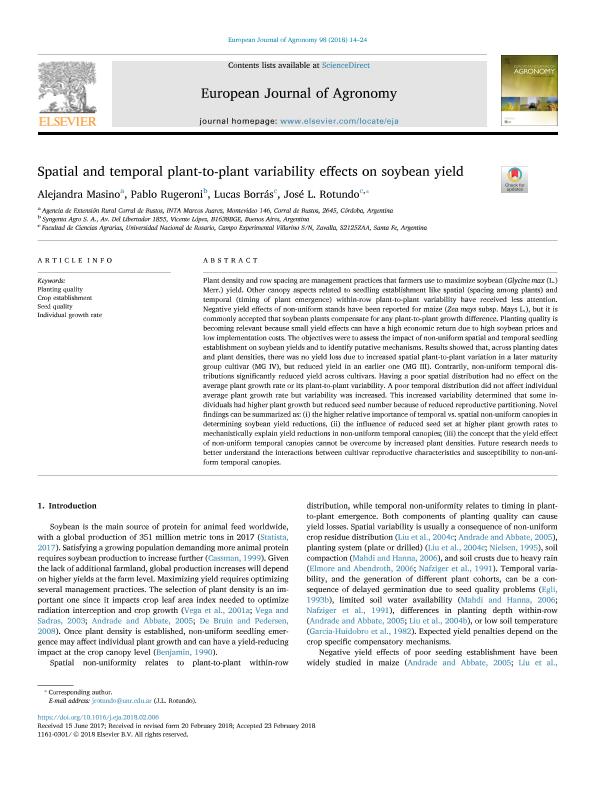Artículo
Spatial and temporal plant-to-plant variability effects on soybean yield
Fecha de publicación:
08/2018
Editorial:
Elsevier Science
Revista:
European Journal of Agronomy
ISSN:
1161-0301
Idioma:
Inglés
Tipo de recurso:
Artículo publicado
Clasificación temática:
Resumen
Plant density and row spacing are management practices that farmers use to maximize soybean (Glycine max (L.) Merr.) yield. Other canopy aspects related to seedling establishment like spatial (spacing among plants) and temporal (timing of plant emergence) within-row plant-to-plant variability have received less attention. Negative yield effects of non-uniform stands have been reported for maize (Zea mays subsp. Mays L.), but it is commonly accepted that soybean plants compensate for any plant-to-plant growth difference. Planting quality is becoming relevant because small yield effects can have a high economic return due to high soybean prices and low implementation costs. The objectives were to assess the impact of non-uniform spatial and temporal seedling establishment on soybean yields and to identify putative mechanisms. Results showed that, across planting dates and plant densities, there was no yield loss due to increased spatial plant-to-plant variation in a later maturity group cultivar (MG IV), but reduced yield in an earlier one (MG III). Contrarily, non-uniform temporal distributions significantly reduced yield across cultivars. Having a poor spatial distribution had no effect on the average plant growth rate or its plant-to-plant variability. A poor temporal distribution did not affect individual average plant growth rate but variability was increased. This increased variability determined that some individuals had higher plant growth but reduced seed number because of reduced reproductive partitioning. Novel findings can be summarized as: (i) the higher relative importance of temporal vs. spatial non-uniform canopies in determining soybean yield reductions, (ii) the influence of reduced seed set at higher plant growth rates to mechanistically explain yield reductions in non-uniform temporal canopies; (iii) the concept that the yield effect of non-uniform temporal canopies cannot be overcome by increased plant densities. Future research needs to better understand the interactions between cultivar reproductive characteristics and susceptibility to non-uniform temporal canopies.
Palabras clave:
CROP ESTABLISHMENT
,
INDIVIDUAL GROWTH RATE
,
PLANTING QUALITY
,
SEED QUALITY
Archivos asociados
Licencia
Identificadores
Colecciones
Articulos(IICAR)
Articulos de INST. DE INVESTIGACIONES EN CIENCIAS AGRARIAS DE ROSARIO
Articulos de INST. DE INVESTIGACIONES EN CIENCIAS AGRARIAS DE ROSARIO
Citación
Masino, Alejandra; Rugeroni, Pablo; Borras, Lucas; Rotundo, José Luis; Spatial and temporal plant-to-plant variability effects on soybean yield; Elsevier Science; European Journal of Agronomy; 98; 8-2018; 14-24
Compartir
Altmétricas




